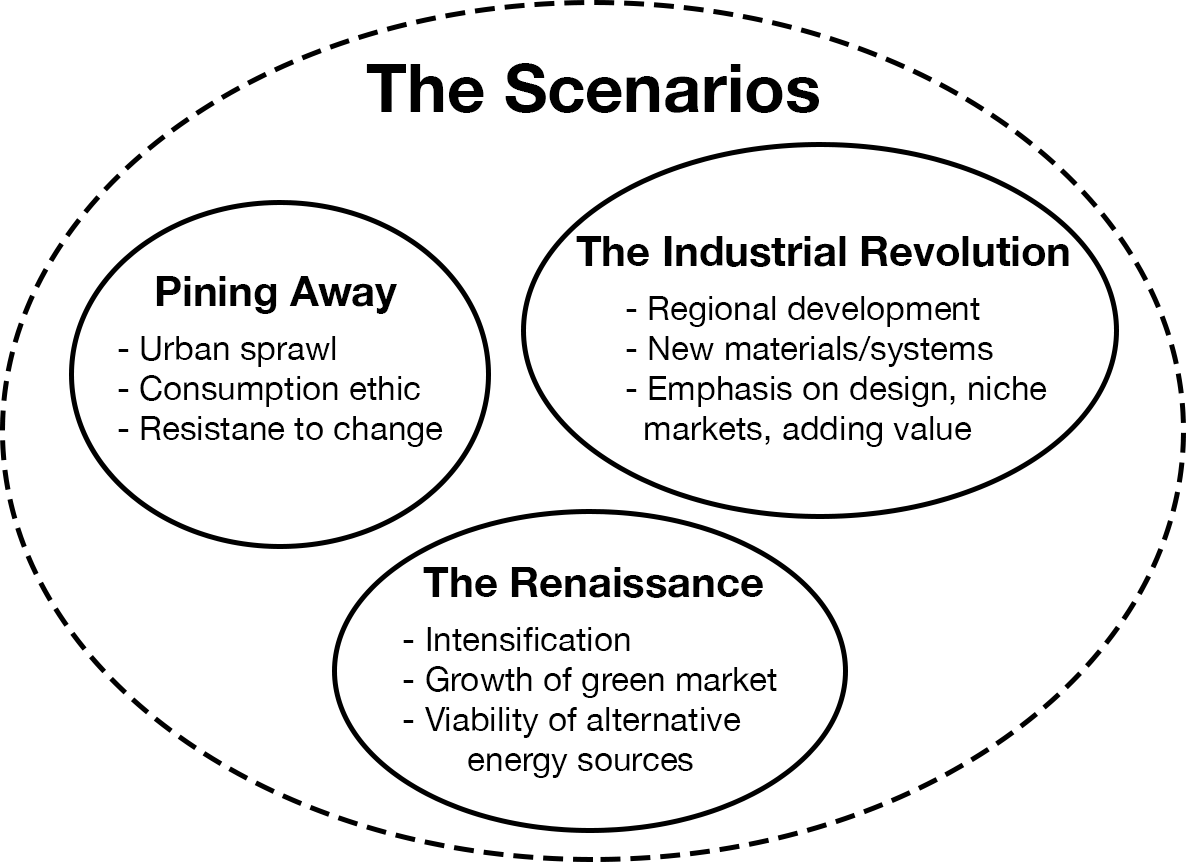2.1 The Meaning of Strategy
After reading this section, students should be able to …
- Explain the meaning of strategy
- Explain the Historical Development of Strategic Planning.
The concept of strategy originates with the art of warfare. According to Webster’s Dictionary, strategy is, “the science or art of combining and employing the means of war in planning and directing large military movements and operations” or “a plan, method, or series of maneuvers or stratagems for obtaining a specific goal or result.” Companies use strategy and the process of strategic planning to reach their economic, social, and environmental goals.
2.1.1 The Concept of Strategy
Historical Development of Strategic Planning
Strategic planning evolved from the process of annual budget planning in the 1950s. In the 1960s, fast-growing demand caused companies to extend their planning horizon beyond an annual basis, making long-range planning necessary. For example, when Rich (1970) wrote his textbook on forest products marketing, he referred to long range planning and business strategy. In long range planning, the future is predicted through extrapolation of historical growth (Ansoff 1984).
Dramatic changes in the business environment, such as the oil shocks of the 70s, required more sophisticated approaches to systems of management. Next came strategic planning where predictions of the future were no longer primarily based on the past (Ansoff 1984). With this new approach, managers began looking for ”vague signs” or potentially important trends that might impact their operations. When one of these vague signs was identified, its development was followed and its impact was considered in the continual process of strategic planning.
Prior to the the 1980s, most planning was done at the corporation’s executive level. During the 80s, strategy development shifted to operating managers, and strategic management became the common term (Wilson 1998). In the 1990s (Kerin 1990) a common term was strategic thinking. Strategic thinking is discovering novel, imaginative strategies and envisioning potential futures very different from the present. In other words, strategic thinking is higher order thinking that should take place to explore potential directions for the company, and strategic planning is the operationalization of those ideas. These two concepts combine to form strategic management (Heracleous 1998). Scenario planning is a tool for enhancing strategic thinking. Like much of strategy, its roots are in military applications but have more recently been applied in business settings. Scion in New Zealand has used scenario planning to envision the future of the built environment in Australasia (Example 4-1).
Example 2.1: Scenario Planning in Australasia
Scion (formerly Forest Research) in New Zealand has used scenario planning in several projects to help its wood industry envision potential futures of housing in the region. One project created three visions for the future urban built environment in Australasia. The project team used existing literature, personal interviews, and group interviews to gather information about the social, economic, environmental, and technological aspects of society. With this information the team created and described three different scenarios of the future: Pining Away, The Industrial Revolution, and The Renaissance. Each scenario is described through the story of an older woman who was a city planner, her husband who was a master carpenter, and her son, a chemical engineer. Using these characters, each scenario is described via a short story of the situation with the family in about the year 2015. The team suggests that the scenarios are not exactly predictions of the future, but should be used as a set when making strategic decisions. In other words, the scenarios are a way of taking complex, and extensive information and combining it in a way that can be digested by strategic planners and effectively utilized in planning processes. An example of one scenario, in its original text, is provided below.
The Renaissance
Jessie stepped out of her apartment building and smiled up at the sun. Taking a deep breath, she smelled the cool air that always resulted from a brisk southerly storm. She enjoyed these refreshing interludes in the increasingly warm and muggy weather. Feeling a rare wave of youthful energy, she headed off to the local shops with a spring in her shuffle.
Taking a short detour through the new sculpture garden, Jessie sat for a while on a park bench and marveled at the transformation. She remembered when this area had been a car park; now it was a pleasant oasis among a cluster of townhouses. Jessie had seen a major turning point in industrial history during her lifetime, and as a town planner she had helped to shape many of the changes. At the turn of the twenty-first century, she and her colleagues had expected consumers to follow green market trends, but nothing had prepared them for the rate at which public consciousness had changed.

In the past, consumers always had a remarkable ability to disregard most environmental problems. When Jessie was young, she remembered, there was concern about pollution, climate change, and resource depletion, but efforts to address these problems never seemed to get anywhere. Finally, a chain of events shifted public opinion to a critical mass and Government intervention was demanded. Hydro lakes slowly became depleted through drought, natural gas fields diminished, and oil prices fluctuated wildly due to supply difficulties. Climatic disasters became common and a crippling cyclone caused widespread blackouts to the city along with major disruptions to transportation. Graced with a mandate for radical change, Smart Growth planners such as Jessie seized the opportunity to rebuild a different type of community.
Other countries were experiencing similar events, but New Zealand and Australia were able to effect change more quickly due to relatively small populations. As a result, Australasia retained significant appeal as a “lifestyle frontier” to migrants and, although international tourism had declined due to rising oil prices, more people came here to live, making urban intensification had been achieved through strong local government leadership, including initiatives such as subsidised public transport systems and multi-unit development along transport corridors. Rural zoning limitations were also tightened to contain urban sprawl so that those wishing to live outside the major cities tended to favour satellite towns within the region. Jessie hadn’t forgotten all the difficulties and challenges they had faced, but tighter stronger communities eventually emerged.
Looking back, it was almost frightening to recall the economic risks they had taken. High transport costs, non-tariff barriers, and the implementation of carbon taxes gave rise to a major push towards self sufficiency, primary production, and a strong service industry. As the population had continued to grow, so did the need for more energy and this led to rapid advancement in sustainable energy technologies. Jessie’s son, Kevin, was currently working as a chemical engineer at the bio-fuel plant constructed near the city. As one of the largest and most productive of its type in the world, it had helped to set the standard for alternative energy supply.
The increased cost of transportation meant the price of imported consumer goods went up, so there was an upsurge in local processing. Manufacturers close to the market could suddenly compete with goods produced by large international producers, and this fostered the development of local businesses around a strong green economy. Within a relatively short time, certification and green branding had become compulsory, sustainable production was strictly enforced, and socially responsible businesses prospered.
While the mass media continued to entice consumers, it seemed to Jessie that people had become disillusioned by rampant materialism. As individuals sought to develop a sense of place and identity in the global context, there had been significant growth of religious, cultural, and community groups. Jessie thought this may have been a reaction to the dumbing-down effects of globalism. Or maybe, with ever-increasing numbers of elderly people in the population — like herself — society was just growing up.
As she stared across at a beautiful wooden sculpture, Jessie reflected on how the new society was built on a strong sense of tradition and creative expression. When it came to the crunch, people had turned to their roots for the answers and the economy found its strength in the land. The value of producing food and fibre in a world of increasingly scarce resources had been realised and primary producers capitalised on their comparative advantage by building a strong knowledge economy around agriculture and forestry.
Jessie had experienced this trend most keenly through the work of her late husband, Jim. As a master builder he witnessed many changes after building standards were tightened to ensure higher energy efficiency. Much to Jim’s approval, solid wood had provided the best solutions for construction. Not only did it have better thermal insulation properties than other materials, it was also more energy-efficient to produce. An oversupply of radiata pine resulted in timber being used in a variety of applications, and Jessie had been amazed at the range of ideas borne of necessity. One of Jim’s favourite projects had been the construction of concept homes demonstrating energy efficient and stylish use of wood-based construction systems.
Diminishing landfill space also prompted more use of wood and other organic materials as local bodies pushed for zero-waste. Laws had made the cost of demolition almost prohibitive and so building systems evolved around durable low-maintenance exteriors and easily modified interiors to suit individual tastes. Jim had also been heavily involved in the refurbishment of existing housing stock to meet new energy codes. Jessie smiled to herself as she recalled how former State-housing tracts had become trendy suburbs. Their construction from native timber, combined with clever refitting, had made them desirable to an extent that would never have been believed 50 years ago.
Still, changes like these had been par for the course. Looking back, it amazed Jessie how well people had adapted when circumstances dictated it. A bird caught her eye as it flitted around the sculptures and she smiled when she noticed a nest tucked among the artistic curves. Humans may have been slow to learn the art of compromise, but they were getting there. How could they not, when nature provided such good role- models (Bates S 2001)?
It is important to note that individual companies also evolve through the stages listed above. As a first step, companies develop budget plans on an annual basis. As they gain experience in the marketplace, they begin to forecast beyond an annual basis and move toward long range planning. As the expertise of company personnel grows, the tools for true strategic planning and strategic management are developed.
Reference:
- Ansoff, H.I. 1984. Implementing Strategic Management. Prentice/Hall International. Englewood Cliffs, New Jersey. 510 pp.
- Kerin, R.A., V. Mahajan, and P.R. Varadarajan. 1990. Contemporary Perspectives on Strategic Market Planning. Allyn and Bacon. Needham Heights, Massachussets. 453 pp.
- Wilson, Ian. 1998. Strategic Planning for the Millennium: Resolving the Dilemma. Long Range Planning. 31(4):507-513
- Heracleous, L. 1998. Strategic Thinking or Strategic Planning. Long Range Planning. 31(3):481-487.
- Bates S., K. Bayne, and S. Killerby. 2001. Forest Research Bulletin No. 224. Forest Research. Rotorua, New Zealand. 45 pp. www.scionresearch.com
- Rich, S.U. 1970. Marketing of Forest Products: Text and Cases. McGraw-Hill, Inc. New York, New York. 712 pp.
Source:
Section 2.1 Meaning of strategy is edited and adapted from ‘Chapter 4: Strategy and Strategic Planning’ from the textbook ‘Strategic Marketing in the Global Forest Industries – Third Edition,’ authored by Eric Hansen & Heikki Juslin, 2018 – this book was licensed under a Creative Commons Attribution-NonCommercial 4.0 International License.


